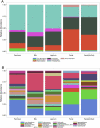Disturbances of the Perioperative Microbiome Across Multiple Body Sites in Patients Undergoing Pancreaticoduodenectomy
- PMID: 27846140
- PMCID: PMC5235958
- DOI: 10.1097/MPA.0000000000000726
Disturbances of the Perioperative Microbiome Across Multiple Body Sites in Patients Undergoing Pancreaticoduodenectomy
Abstract
Objective: The goals of this study were to characterize bacterial communities within fecal samples, pancreatic fluid, bile, and jejunal contents from patients undergoing pancreaticoduodenectomy (PD) and to identify associations between microbiome profiles and clinical variables.
Methods: Fluid was collected from the pancreas, common bile duct, and proximal jejunum from 50 PD patients. Postoperative fecal samples were also collected. The microbial burden within samples was quantified with droplet digital polymerase chain reaction. Bacterial 16S ribosomal RNA gene sequences were amplified, sequenced, and analyzed. Data from fecal samples were compared with publicly available data obtained from volunteers.
Results: Droplet digital polymerase chain reaction confirmed the presence of bacteria in all sample types, including pancreatic fluid. Relative to samples from the American Gut Project, fecal samples from PD patients were enriched with Klebsiella and Bacteroides and were depleted of anaerobic taxa (eg, Roseburia and Faecalibacterium). Similar patterns were observed within PD pancreas, bile, and jejunal samples. Postoperative fecal samples from patients with a pancreatic fistula contained increased abundance of Klebsiella and decreased abundance of commensal anaerobes, for example, Ruminococcus.
Conclusions: This study confirms the presence of altered bacterial populations within samples from PD patients. Future research must validate these findings and may evaluate targeted microbiome modifications to improve outcomes in PD patients.
Figures





References
Publication types
MeSH terms
Substances
Grants and funding
LinkOut - more resources
Full Text Sources
Other Literature Sources
Medical

